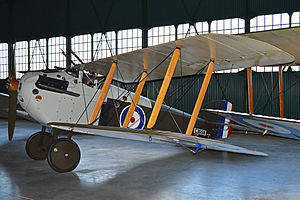Sopwith Dolphin
| 5F.1 Dolphin | |
|---|---|
 |
|
| Dolphin Mk I composite airframe displayed at the Royal Air Force Museum London, 2013 | |
| Role | Fighter |
| Manufacturer | Sopwith Aviation Company |
| Designer | Herbert Smith |
| First flight | 23 May 1917 |
| Introduction | February 1918 |
| Primary users |
Royal Flying Corps Royal Air Force |
| Number built | 2,072 |
The Sopwith 5F.1 Dolphin was a British fighter aircraft manufactured by the Sopwith Aviation Company. It was used by the Royal Flying Corps and its successor, the Royal Air Force, during the First World War. The Dolphin entered service on the Western Front in early 1918 and proved to be a formidable fighter. The aircraft was not retained in the postwar inventory, however, and was retired shortly after the war.
In early 1917, Sopwith's chief engineer Herbert Smith began designing a new fighter (internal Sopwith designation 5F.1) powered by the geared 200 hp Hispano-Suiza 8B. The resulting Dolphin was a two-bay, single-seat biplane. The upper wings were attached to an open steel cabane frame above the cockpit. To maintain the correct centre of gravity, the lower wings were positioned 13 inches forward of the upper wings, creating the Dolphin’s distinctive negative wing stagger. The pilot sat with his head raised through the frame, where he had an excellent field of view. This configuration sometimes caused difficulty for novice pilots, who found it difficult to keep the aircraft pointed at the horizon because the nose was not visible from the cockpit. The cockpit was nevertheless warm and comfortable, in part because pipes ran alongside the cockpit walls to the two side-mounted radiator blocks. Shutters in front of each radiator core allowed control of engine temperature.
The first Dolphin prototype was powered by a geared 150 hp Hispano-Suiza 8 and featured a deep "car-type" frontal radiator. Test pilot Harry Hawker carried out the maiden flight on 23 May 1917. In early June, the prototype was sent to Martlesham Heath for official trials. On 13 June, the prototype flew to Saint-Omer, France, where the aircraft's unfamiliar shape prompted Allied anti-aircraft gunners to fire on it. Several pilots, including Billy Bishop of No. 60 Squadron, evaluated the prototype and reported favorably on it. On 28 June 1917, the Ministry of Munitions ordered 200 Dolphins from Hooper & Co. Shortly thereafter, the Ministry ordered a further 500 aircraft from Sopwith and 200 aircraft from Darracq Motor Engineering Company
...
Wikipedia
